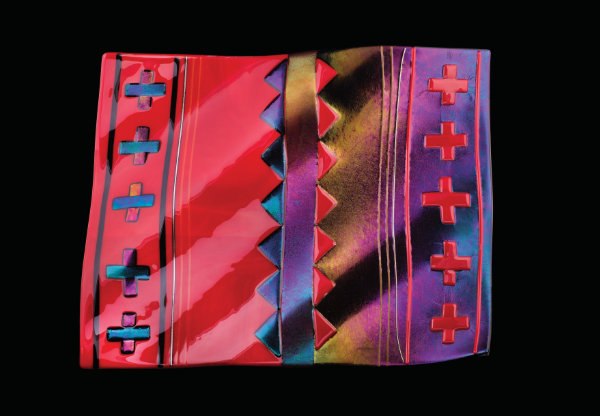Memento Mori
 Carol Lujan (Diné), Grandmother’s Legacy series, 2014. Cut and fused glass. 14 1⁄2 × 12 × 1 1⁄2 in. Photograph by Stephen Lang. Courtesy Carol Lujan.
Carol Lujan (Diné), Grandmother’s Legacy series, 2014. Cut and fused glass. 14 1⁄2 × 12 × 1 1⁄2 in. Photograph by Stephen Lang. Courtesy Carol Lujan.
By Charlotte Jusinski
My dog died during the production of this magazine.
Maybe it’s not standard for these editor’s letters to go this way. We need to stay professional, we need to keep it clean, we need to stay a bit cold and stoic. Stick to business. Don’t get too personal. Don’t get personal at all.
If you know me, however, you know that the above sentiment is one that I buck. I am obsessed with being human; with being messy. There is deep understanding and compassion available when we expose the things we impulsively keep hidden.
And what is art and culture and history if not deeply human? We can talk all we want about historical events and cultural trends—but if we forget that there were and are thinking, breathing, bleeding human beings at the core of all of these subjects, we lose sight of the very thing that makes a magazine like this relevant.
So, that brings me to my dog. He was wonderful. I loved him deeply and fiercely. And he died while I was putting together this issue for you.
For many days before and after, it was hard to work; I’m sure every person reading this has been through an event that makes your day job impossible. But once I broke through the fog of acute grief, I took solace in these pages.
I’ve been editor of El Palacio since July 2019, and the stories that have stuck with me most since then have been ones that expose the softer underbelly of the history, art, and even geography of the Southwest.
In our Winter 2019 issue, in “From Ineffable to Incandescent,” Dr. Nicole Panter Dailey entered the New Mexico Museum of Art’s exhibition of Agnes Pelton’s transcendent abstract paintings through the lens of the painter’s psychological trauma; Dr. Panter Dailey didn’t just look at the works of art, she investigated the intense emotions that went into creating such luminous masterpieces, to great effect.
Spring 2020 featured “Adulation and Anguish,” in which Hugo Chapman of the British Museum reminded us that not only does the story of Christ include every human emotion there could possibly be, but the Museum of Art’s exhibition of devotional drawings encouraged the viewer to get in close; the drawings were small, inviting visitors to practically put their nose to the glass to see their detail.
In Fall 2020, Dr. Larry Crumpler of the New Mexico Museum of Natural History and Science singlehandedly made that issue the most requested one of my tenure here with his lengthy piece, “Land of a Thousand Volcanoes.” Dr. Crumpler oozed his passion for the geology of New Mexico right onto the page. It would have been so easy for that story to have been dry as a bone, but Dr. Crumpler is far too human to let that happen.
Also in Fall 2020 was Emily Withnall’s “Native Tongues,” a touching profile of photographer Kenji Kawano. Not only is Kawano a fascinating individual, but Withnall’s breathtaking prose makes the story of the photographer’s relationship with Navajo Code Talkers engaging and heart-rending.
These are just a few selections; this doesn’t even touch on Molly Boyle’s “Whatever Decided Them” in Spring 2021, “Corridos My Father Sang to Me” by Rob Martinez in Summer 2020, Dr. Frances Levine’s “A Beautiful Death on the Santa Fe Trail” in Spring 2020, Fall 2019’s acclaimed “Spinster Acts” from Ethan Ortega, and many more. Humanity is rampant in every issue of El Pal.
So, please enjoy this issue of El Palacio in honor of all that is human within us (and, if you’re so inclined, in celebration of all that is canine around us). It’s not always clean, and in fact it’s often ugly—but within these pages, we manage to make it all gorgeous.
—
